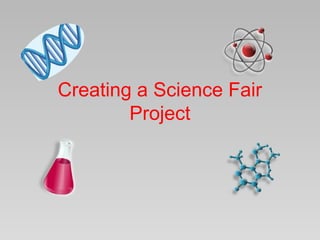
Creating a Science Fair Project
- 1. Creating a Science Fair Project
- 2. Science Projects • What’s the difference between a demonstration and a science project? • A demonstration is conducted just to show information. Nothing is measured or tested. • A science project has a hypothesis and variables that are tested multiple times to prove or disprove the hypothesis.
- 3. Steps to Creating Your Project: 1. Choose your question or problem 2. Do research 3. Make a hypothesis 4. Do the experiment to test your hypothesis 5. Keep a log book during your experiment 6. Observe and record data from experiment 7. State your conclusions 8. Create your notebook and your board
- 4. 1. Title (5 pts) • 8 words or less • Choose something unique or it can be your experiment’s question. • Example: Which type of garbage becomes plant food first?
- 5. 2. Problem (5 pts) • A Problem is a question that can be answered through experimentation. • Start with what YOU are interested in! Example of a problem: Which garbage materials break down the fastest?
- 6. 3. Research (10 pts) • Before beginning the investigation, look for more information to support what you want to learn about. • Use at least 3 sources. If using online sources, look for .org, .gov or .edu, NOT .com. • Write what you learned into a report 3-5 paragraphs in length. • You must have a bibliography of your sources!!!
- 7. 4. Hypothesis (5 pts) • A Hypothesis is a statement that answers the question from the problem. • I think that ________________ because ________. Example of a hypothesis: I think that the grass clippings will compost the fastest because they are smaller in size than the other items.
- 8. 5. Procedure (5 pts) • The Procedure is EXACTLY what you will do step by step. Include photos of the process List in order step by step what you will do: Example: 1. Collect banana peels, apple peels, table scraps, and grass clippings. 2. Place 2 cups of each into a dark container of the same size. 3. Turn items in all containers every four days using a spoon. 4. Take pictures each time. Take written notes each time. 5. Collect data every four days for a period of four weeks. 6. Create a Observation Notes chart and a Display chart of the pictures taken.
- 9. 6. Data 7. Results (5 pts) • The Data is where you keep the records of your results. • Keep it in a log book. • You need at least 10 entries in your log book. • The Results are what the data showed happened. • Use charts and graphs to show your data on your board: – http://nces.ed.gov/nceskids/graphing/classic/
- 10. 8. Conclusion (5 pts) • Your conclusion will restate your hypothesis. • You will also state whether your hypothesis turned out to be correct or incorrect. • Example: My hypothesis stated that the grass clippings would decompose the fastest. I was wrong. The banana peels decomposed faster than the grass clippings.
- 11. 9. Abstract (10 pts) • A Short summary that explains your experiment. • Judges will read your abstract first to get an idea what your project is about.
- 12. 10. Notebook (20 pts) 11. Log book (10 pts) • Your notebook will be a written copy of everything you have on your board. – The Title, abstract, problem, research, hypothesis, procedures, results, conclusion and bibliography – This is different from the log book, which only has your data entries. • You must have both.
- 13. 12. Display (20 pts) • On Three Fold Science Board • Easy to read, well organized, no grammar or spelling errors • Include visual aids (pictures, charts, diagrams, etc) • Neatness is important!
- 14. What Needs to Be on My Board? Title Purpose/Problem Procedure Results 1. 2. 3. Research Conclusion 4. Data: Charts & Graphs Abstract Hypothesis
- 15. Example boards:
- 16. Tips: • Work with a partner (no more than 2 per project) • Do your writing on a computer and print out two copies: one copy for the board, one copy for your notebook • Write in your log book often during your experiment- don’t try to remember it all at the end!!!
- 17. Unit Count for Science Projects • 1 unit for a completed project scored at least a C • 1 additional unit for a project with ALL parts (A) • Projects that earn an A will have a chance to go to the district science fair on February 23. • Units for doing a project 1-2!!!! • These units can be applied to any of your science requirements. Wow! • Projects Due Friday, February 15!
- 18. Websites for Ideas: • http://www.sciencebuddies.org/ • http://www.all-science-fair-projects.com/ • http://www.terimore.com/ • http://www.factmonster.com/ • www.sciencebob.com
